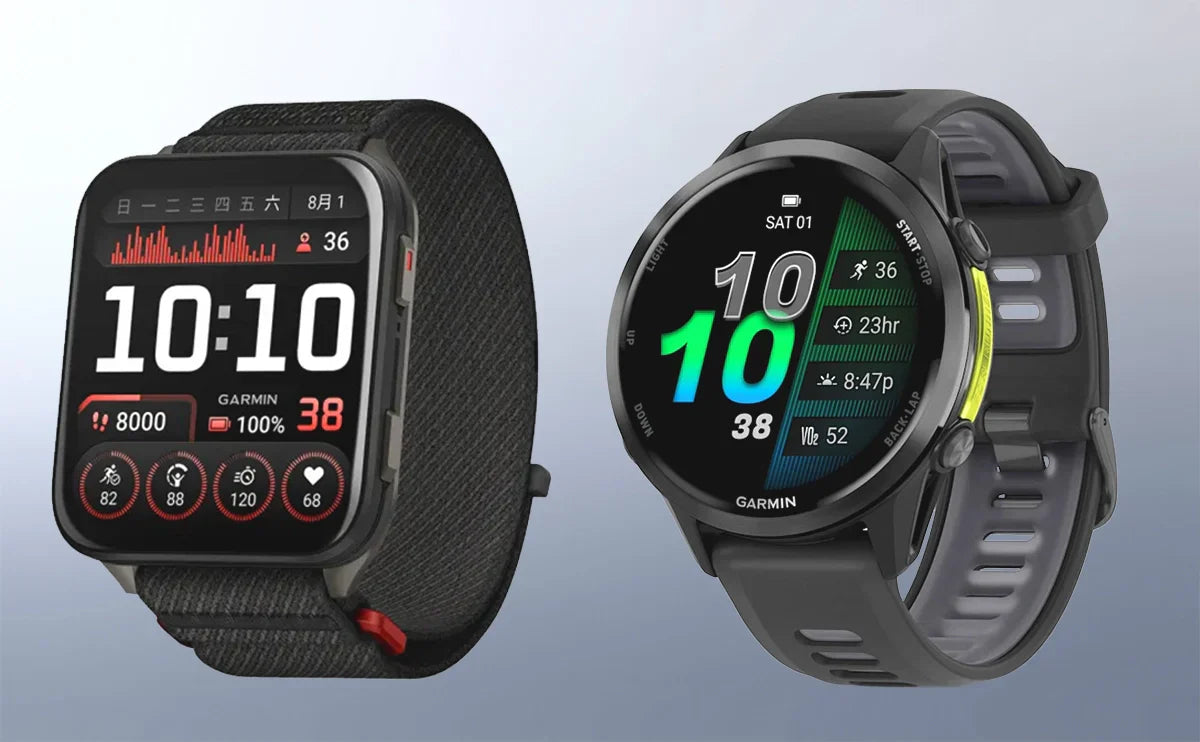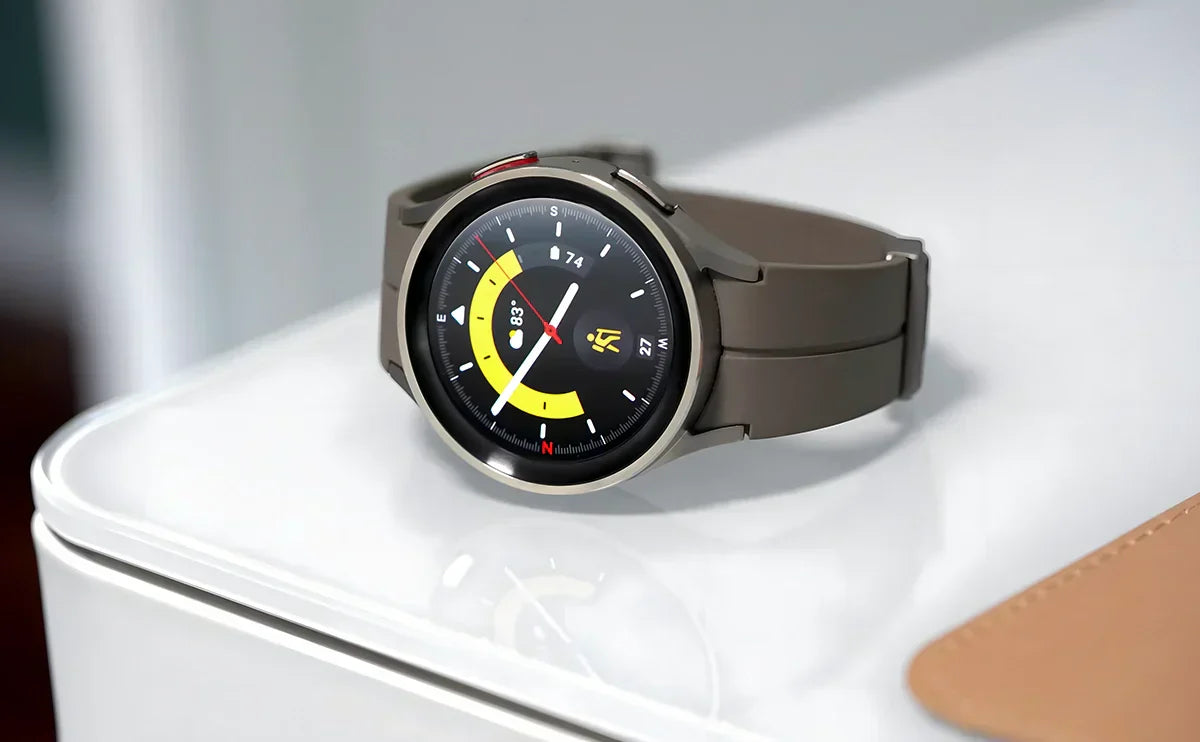Main content:
- Garmin Venu X1 vs. Garmin Forerunner 970 - Specifications
- Design and Size Comparison - Sleek Modern vs. Solid Professional
- Display Comparison - Immersive Large Screen vs. Traditional Practical Design
- Battery Life Comparison - Long-Lasting Power vs. Balanced User Experience
- GPS Accuracy and Navigation Experience - The Perfect Companion for Urban vs Outdoor Challenges
- Health and Fitness Features - Versatile Daily Management vs. Professional Athletic Analysis
- Price Comparison - Is the Venu X1 Worth Its Premium?
- Conclusion: Garmin Venu X1 vs. Forerunner 970 - Who Comes Out on Top?
When choosing a Garmin smartwatch, many users find themselves torn between the Garmin Venu X1 vs. Garmin Forerunner 970. While both belong to Garmin’s premium lineup, they serve very different purposes: the Garmin Venu X1 focuses on sleek design and everyday health tracking, while the Garmin Forerunner 970 is built for serious athletes who demand in-depth training metrics and performance analysis. If you're looking for a smartwatch that balances function and style, both models are worth considering.
This article dives deep into the key differences between the Garmin Venu X1 vs. Garmin Forerunner 970, comparing their design, fitness and health features, battery life, and overall user experience. Keep reading to discover which one is the perfect fit for your lifestyle.
Garmin Venu X1 vs. Garmin Forerunner 970 - Specifications
|
Parameter |
Garmin Venu X1 |
Garmin Forerunner 970 |
|
Target Audience |
Lifestyle health smartwatch |
Professional sports training watch |
|
GPS System |
GPS + GLONASS + Galileo |
Dual-frequency GPS (L1+L5) + GLONASS + Galileo |
|
Sports Modes |
Various daily fitness and sports |
Professional running, triathlon, and multiple sports modes |
|
Training Features |
Basic workout guidance and animations |
Advanced training analysis and recovery guidance |
|
Heart Rate Monitoring |
All-day optical heart rate monitoring |
High-precision heart rate and HRV analysis |
|
Smart Features |
Notifications, music, Garmin Pay, etc. |
Notifications, basic music control |
|
Battery Life |
About 10 days smart mode, 20 hours GPS mode |
About 14 days smart mode, 36 hours GPS mode |
|
Water Resistance |
5 ATM (50 meters) |
5 ATM (50 meters) |
|
Price (Estimate) |
Around $400 USD |
Around $800 USD |
Design and Size Comparison - Sleek Modern vs. Solid Professional
The Garmin Venu X1 and Forerunner 970 showcase distinct differences in design and size while both maintaining Garmin’s high standards of quality. Both feature titanium and sapphire crystal for durability and premium feel. However, the Venu X1 breaks away from the traditional round shape with a sleek, slim rectangular design measuring approximately 41×46×7.9mm and weighing just 34g. Its clean, streamlined lines offer a modern, stylish look, making it ideal for everyday wear and users seeking lightweight comfort. This design approach follows the modern aesthetic also seen in the Garmin Venu 3, appealing to users who value both style and function. You can also check Garmin Venu X1 vs Garmin Venu 3.
In contrast, the Forerunner 970 sticks to the classic round dial, sized at 47×47×12.9mm and weighing around 56g, giving it a more substantial and robust presence. Combined with a titanium bezel and multiple physical buttons, it emphasizes durability and functionality tailored for serious athletes. Its rounded contours and solid build convey reliability, perfectly suited for intensive training and outdoor use. This rugged philosophy aligns closely with the Garmin Forerunner 965, another performance-focused model known for its athletic features and durability. You can also read the article of Garmin 970 vs 965.
Overall, the Venu X1 focuses on lightweight design and contemporary style, while the Forerunner 970 prioritizes professional features and ruggedness to meet different user needs and preferences. For those considering alternatives with a balance between modern style and functionality, the Garmin Forerunner 570 might also offer a compelling middle ground. The article of Garmin Forerunner 970 vs. Garmin Forerunner 570 can be explored.
Winner: Garmin Venu X1
Reason: With its ultra-slim profile and modern rectangular design, the Venu X1 excels in comfort and style, making it the better choice for most users’ everyday wear.

Display Comparison - Immersive Large Screen vs. Traditional Practical Design
Both the Garmin Venu X1 and Forerunner 970 feature AMOLED displays, but there are clear differences in screen size and shape. The Venu X1 offers a 2-inch rectangular screen with a display area of 1304 mm² and a resolution of 448×486 pixels. Its sharp, vibrant visuals and excellent brightness ensure great readability even under strong sunlight, making it ideal for users who prefer a larger, more immersive display experience.
In contrast, the Forerunner 970 comes with a 1.4-inch circular screen at a resolution of 454×454 pixels. While its resolution is slightly higher, the smaller display area means less information is shown at once. Its design aligns more with traditional watch use and athletic needs. The brightness is also impressive, providing clear visibility during outdoor activities.
Overall, the Garmin Venu X1 vs. Garmin Forerunner 970 comparison shows that the Venu X1 suits users seeking vivid visuals and larger screen space, whereas the Forerunner 970 focuses on practicality and portability for sports.
Winner: Garmin Venu X1
Reason: With its larger screen and superior brightness, the Venu X1 delivers a better display experience that meets a wider range of user needs.
Battery Life Comparison - Long-Lasting Power vs. Balanced User Experience
The Garmin Venu X1 and Forerunner 970 show notable differences in battery performance. The Forerunner 970 offers up to 15 days of battery life in smartwatch mode, 4 days with Always-On Display (AOD) enabled, and up to 26 hours in GPS mode - making it ideal for extended training sessions and outdoor activities. This impressive endurance is comparable to models like the Garmin Fenix 8, which also targets athletes needing reliable long-lasting power. In contrast, the Venu X1 lasts about 8 days in smartwatch mode, drops to 2 days with AOD on, and provides around 14 to 16 hours in GPS mode. While its battery life is shorter, the Venu X1 delivers a larger screen and superior display experience for comfortable daily use. You can also explore Garmin Forerunner 970 vs Fenix 8.
Both watches support multi-satellite positioning and music playback, but under power-intensive scenarios, the Forerunner 970’s battery advantage stands out, catering to heavy-duty athletes. Meanwhile, the Venu X1 focuses more on balancing daily health management with visual comfort.
Winner: Garmin Forerunner 970
Reason: Its longer battery life and robust GPS capabilities offer more reliable power for prolonged workouts and outdoor use.

GPS Accuracy and Navigation Experience - The Perfect Companion for Urban vs Outdoor Challenges
The Garmin Venu X1 vs. Garmin Forerunner 970 comparison reveals distinct strengths in GPS accuracy and map navigation. The Venu X1 supports multiple satellite systems including GPS, GLONASS, Galileo, and Beidou, offering stable and quick positioning. It excels in urban running and cycling with accurate route tracking. Its large 2-inch screen and responsive touch controls provide a clear and intuitive navigation experience, making daily use convenient. In practice, positioning is precise in open areas but may occasionally fluctuate in dense urban environments or complex terrains.
The Forerunner 970 features multi-frequency GNSS and smart Satiq technology that dynamically optimizes positioning accuracy and battery life. From personal experience, it maintains stable GPS signals in mountainous and forested areas, accurately recording running routes and distances. Its professional maps support off-road route planning and automatic track switching on athletics tracks. The combination of physical buttons and touchscreen offers flexible operation suited to varied scenarios.
Overall, the Venu X1 delivers excellent visual clarity and straightforward navigation for urban users, while the Forerunner 970 stands out with superior GPS precision and advanced mapping for outdoor adventures and intense training.
Winner: Garmin Forerunner 970
Reason: Its multi-frequency GNSS and intelligent positioning technology ensure accurate navigation even in challenging environments, meeting the demands of serious outdoor athletes.

Health and Fitness Features - Versatile Daily Management vs. Professional Athletic Analysis
The Garmin Venu X1 vs. Garmin Forerunner 970 offer distinct strengths in health monitoring and fitness capabilities, catering to different user needs. Both watches feature the 5th-generation Elevate heart rate sensor, supporting all-day heart rate tracking, blood oxygen saturation, respiration rate, stress assessment, and sleep analysis, providing comprehensive insight into your physical condition. The Venu X1 leans toward everyday health management, integrating features like Body Battery, sleep coaching, and skin temperature tracking, along with over 100 sport modes including animated workout guidance, ideal for users seeking diverse fitness experiences and a holistic healthy lifestyle.
In contrast, the Forerunner 970 targets serious athletes, offering ECG functionality for more precise cardiac health data. Its fitness features focus on running and triathlon training with advanced metrics such as running economy, running tolerance, and step cadence loss, helping athletes optimize efficiency and reduce injury risks. Additionally, it supports race prediction and dedicated training plans, with a hybrid button and touchscreen interface enhancing usability and precision for professional training.
Overall, the Venu X1 delivers an easy-to-use, comprehensive experience in health and fitness tracking suitable for lifestyle and recreational users, while the Forerunner 970 excels with in-depth data analysis and specialized training tools, making it the perfect choice for high-intensity and competitive athletes.
Winner: Garmin Forerunner 970
Reason: With its precise health monitoring and professional-grade fitness analytics, the Forerunner 970 offers unparalleled support for users aiming for peak athletic performance and scientific training management.

Price Comparison - Is the Venu X1 Worth Its Premium?
Both the Garmin Forerunner 970 and Venu X1 are high-end smartwatches priced for serious users. The Forerunner 970 is priced at $749.99, making it more accessible to advanced runners and triathletes. In contrast, the Venu X1, launched in June 2025, is priced at $799.99-positioning it closer to lifestyle-focused premium models like the Apple Watch Ultra 2.
However, the higher price tag of the Venu X1 has sparked debate among reviewers. Despite its elegant design and AMOLED display, it lacks key high-end features such as ECG, multi-band GPS, and LTE. This makes its value questionable when compared to the more affordable Forerunner 965 or the versatile Fenix series.
The Forerunner 970, though $150 more expensive than the 965, includes enhanced ECG functions and endurance training tools, making it a better fit for athletes who need performance-driven metrics.
Winner: Garmin Forerunner 970
Reason: It offers a more balanced combination of price and performance, especially for serious runners and triathletes.

Conclusion: Garmin Venu X1 vs. Forerunner 970 - Who Comes Out on Top?
Both the Garmin Venu X1 and Forerunner 970 offer distinct advantages. The Venu X1 stands out with its ultra-slim design, stylish aesthetics, and robust health monitoring features. It also excels in specialized activities like golf and eSports, making it an attractive option for users who prioritize lifestyle and versatility.
However, when it comes to core performance and training-focused features, the Forerunner 970 clearly takes the lead. With significantly longer battery life, higher-precision multi-band GNSS positioning, ECG support, and advanced running metrics like running economy and endurance, it’s the go-to choice for serious athletes and data-driven runners.
Each watch targets a different audience and serves its purpose well, but if your focus is on accurate training, in-depth insights, and long-term performance, the Forerunner 970 is the clear winner.
Final Verdict: Garmin Forerunner 970
Why: It surpasses in battery life, GPS accuracy, health tracking, and pro-level training tools - ideal for dedicated fitness enthusiasts.




Share:
Apple Watch SE vs Series 8 - Full Comparison and Buyer’s Guide
Garmin Forerunner 570 vs 965 - Key Differences Explained